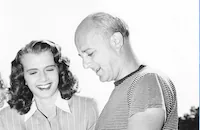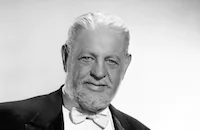Chain Gang
Brief Synopsis
Cast & Crew
Lew Landers
Douglas Kennedy
Marjorie Lord
Emory Parnell
William "bill" Phillips
Thurston Hall
Film Details
Technical Specs

Synopsis
After three convicts are killed during a chain gang riot, a state senator accuses officials of covering up mistreatment of prisoners and introduces legislation to abolish chain gangs, but the legislation is defeated for lack of concrete evidence. Later, reporter Cliff Roberts, who writes for the liberal Standard , and Rita McKelvey, a reporter for the rival Chronicle , have lunch together. Although her wealthy stepfather, John McKelvey, disapproves of Cliff and his politics, Rita is in love with him, and like him, believes that certain powerful people have a vested interest in maintaining the chain gangs. To obtain evidence of abuse, Cliff arranges with his editor, "Pop" O'Donnell, to work undercover as a chain gang guard. After telling Rita that he is going on a fishing vacation, Cliff, who is using the name Jack Granger, reports to the unsuspecting Captain Duncan at Cloverdale prison. After a few days of training, Cliff is sent out with a road gang. Watching the gang at work is Harry Cleaver, a representative of the construction company. Cliff witnesses him offering to pay the guards an inducement if the convicts finish the road ahead of schedule. Later, Cliff is forced to whip convict Roy Snead to prove that he is not soft on the men. Ashamed of his actions, Cliff sneaks out during the night and brings Snead some food. After the Standard advertises their expose of chain gangs, Rita overhears McKelvey discussing the situation with her editor, Lloyd Killgallen, and Cleaver. When she learns from their conversation that her father owns the Chronicle and illegally uses convict labor on his construction projects, Rita quits her job and joins the Standard staff. The paper runs Cliff's article, accompanied by photographs taken with a camera hidden in a cigarette lighter. While discussing the article with an angry McKelvey, Cleaver spots a photograph of Rita and Cliff and, recognizing Cliff as "Granger," the new chain gang guard, declares that he must be the spy. McKelvey telephones Duncan with the information, and he beats up Cliff with the help of the other guards. Meanwhile, Snead escapes from the chain gang. Leaving one guard behind to watch Cliff, the others pursue Snead. Cliff then overcomes his guard and runs away. Duncan shoots the fleeing Cliff and leaves him for dead. Snead discovers Cliff, and remembering his kindness, cleans his wound and helps him to a nearby farmhouse before continuing his escape. Later, Snead is killed and blamed for Cliff's death. With the help of the woman who lives on the farm, Cliff recovers. Unknown to him, however, she recognizes his uniform and innocently asks the doctor to report his location to the prison. Cliff learns what she has done and escapes just ahead of the guards. Once Cliff returns home safely, the corrupt officials are arrested, and McKelvey is indicted.

Director

Lew Landers
Cast

Douglas Kennedy

Marjorie Lord
Emory Parnell
William "bill" Phillips

Thurston Hall
Harry Cheshire
Don Harvey
William Lechner
George Eldredge
William Tannen
Frank Wilcox
Rusty Wescoatt

George Robotham
Dorothy Vaughan
William Fawcett
Crew
Roger M. Andrews
Mischa Bakaleinikoff
Sidney Clifford
Howard J. Green
Sam Katzman
Herbert Leonard
Ira H. Morgan
Paul Palmentola
Aaron Stell
Josh Westmoreland

Film Details
Technical Specs

Articles
Chain Gang (1950)
For a single season, Kennedy was the star of the syndicated western TV series Steve Donovan - Western Marshal (1955) and he later had a recurring role as a lawman on The Big Valley (1965-1969). Kennedy's Chain Gang leading lady Marjorie Lord was at this point only a few years from her career-defining role as Danny Thomas' wife on the long-running ABC sitcom Make Room for Daddy (1953-1965). Lord's daughter is the actress Anne Archer. Born Louis Friedlander in New York City in 1901 , Lew Landers worked his way up to the director's chair via a string of menial jobs at Universal - among them, a crew position on the set of Paul Leni's The Man Who Laughs (1928). Under his birth name, Landers worked as an assistant director and later helmed serials - among them the quasi-sci-fi revenge tale The Vanishing Shadow (1928) with Onslow Stevens and the western chapter play The Red Rider (1934) with Buck Jones - before Universal entrusted him with his first feature: The Raven (1935), starring Boris Karloff and Bela Lugosi. Although Landers was paid a mere $900 for his work on The Raven he developed a reputation for reliability and for being able to coax a wealth of atmosphere from the most meager of budgets. Landers adopted the name change with RKO in 1937 and later at Columbia, where he was put to work in the studio's B-movie mill.
A dab hand at any film genre, Landers churned out an impressive 150 features in his lifetime, including crime films (Smashing the Rackets, 1938), war stories (Ski Patrol, 1940), spook shows (The Return of the Vampire with Bela Lugosi in 1944), comedies (The Boogie Man Will Get You, with Boris Karloff in 1942) and more westerns (Cowboy Canteen, 1944). Landers' efficiency helped him transition to television and multiple episodes of Adventures of Superman, Highway Patrol and Bat Masterson. As was the case with many workaholics in Hollywood (and particularly at Columbia), Landers' work outlived him: his final film, Terrified (1963), was released four months after his death from myocardial infarction in Palm Desert, California, on December 16, 1962, just two weeks shy of his 61st birthday.
Producer: Sam Katzman
Director: Lew Landers
Screenplay: Howard J. Green
Cinematography: Ira H. Morgan
Art Direction: Paul Palmentola
Film Editing: Aaron Stell
Cast: Douglas Kennedy (Cliff Roberts), Marjorie Lord (Rita McKelvey), Emory Parnell (Capt. Duncan), William Phillips (Roy Snead), Thurston Hall (John McKelvey), Harry Cheshire ('Pop' O'Donnell).
BW-70m.
by Richard Harland Smith
Sources:
Crime Movies: An Illustrated History by Carlos Clarens (W. W. Norton & Company, 1980)
Golden Horrors: An Illustrated Critical Filmography, 1931-1939 by Bryan Senn (McFarland & Company, 1996)
Universal Horrors: The Studio's Classic Films, 1931-1946 by Michael Brunas, John Brunas and Tom Weaver (McFarland & Company, 1990)














